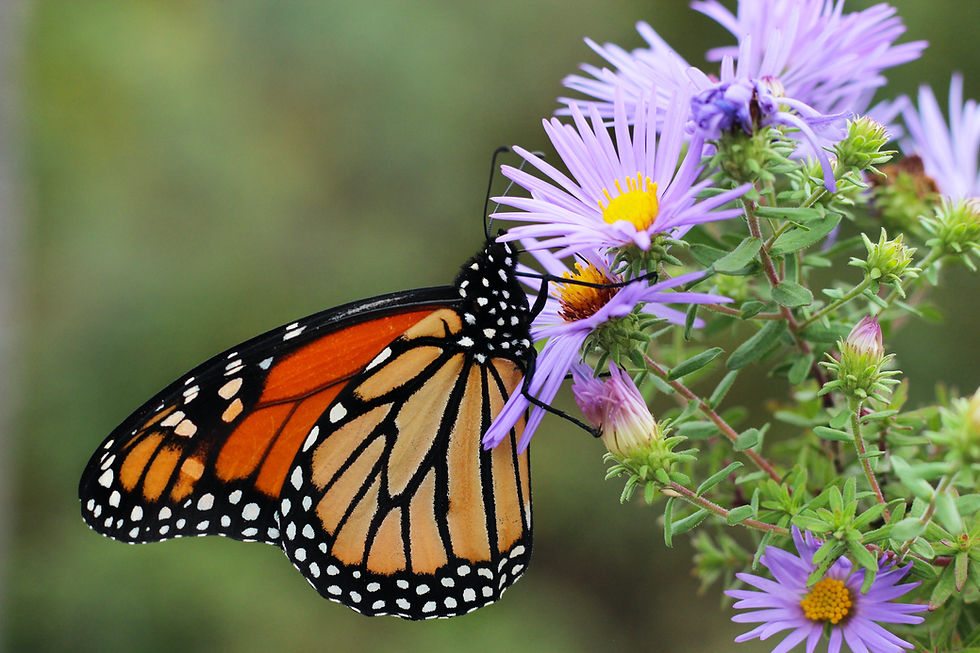Benefits of Planting Native Plants on your Property
- VanderWaal

- Apr 3
- 4 min read
Updated: Apr 5
Have you every googled the benefits of native plants? You will undoubtedly find article after article on the importance of native plants in our ecosystems. The amount of information can be quite overwhelming as you begin to spiral into the world of unique features and contributions of each individual plant species. The benefits I share below are some that I find hold a level of importance when considering the inclusion of native plants on my property. This is in no way a complete list of contributions these plants offer to our local ecosystem, but I do highlight some pretty incredible things.

Plants that exist on our native species list offer some of the most unique forms, textures, shapes, colors, and contributions to our natural landscape. And while some of us plant prairie grasses and native forbs in large scales, these plants can offer the same benefits in even the smallest of settings.
Benefit #1: It's All About the Bugs!
Biodiversity is a ground up program! 90% of the worlds insects are specialists. Simply put, bugs specialize in one specific plant for food or reproduction. These native insects have evolved with native plants to be able to digest potential toxins that other insects cannot. Some need specific plants upon which to lay eggs or larvae for successful reproduction. Some of the more well known examples are the endangered Karner Blue Butterfly that relies solely on Sundial Lupine for its caterpillars to eat or the Monarch caterpillar who can digest the toxic glycoside compounds of Milkweed.
Consider the White Oak: The White Oak supports over 500 species of caterpillars critical to the diet of many of our state's songbirds. Additionally, during the White Oak mast years, thousands of acorns feed the wildlife below. When we eliminate native plants from our property, the specialists that need those plants to survive will no longer exist on our property. Healthy native insect populations attract birds and other predators thus increasing biodiversity in an area. Aside from all the bugs, the majority of our state mammals have a preference for browsing the leaves, stems, and berries of our plants as an important part of their diet.
Strive for ecological balance on your property. While some of the non native plants in our landscape have the ability to provide beautiful gardens, you can be sure that the majority of these specialist insects have no ability to utilize that plant for survival.
Benefit #2: Native Plants are Low Maintenance
Simple Fact: Plants that are native to a region have evolved to handled the temperatures, soil types, precipitation, predators, and any other potential harsh factors that a particular region can throw at them.
You might say "Hey the plants in my landscape are doing just fine in our region!" Truth is, they probably are. However in most traditional landscape settings the inputs that it takes to make that landscape beautiful far outnumber the needs of a native plant, which after establishment are minimal if at all. Fertilizer, mulching, irrigation, weeding, pruning, and pest management are all a part of the list of chores associated with traditional landscape.
By no means am I ragging on traditional landscaping, as areas of my own property still include Hostas, Hydrangeas, and some other beauties. Just repeat the mantra "Right Plant, Right Place." Native plants belong in their native ecosystems.
Benefit #3: Competition for Invasive Species
It's one thing to remove the invasive species and another to replace them. Due to the fact that native plants are so successful in their particular region, evidence is being found that replanting recently recovered areas of invasive species with native species can greatly reduce re-sprouts and takeovers of certain invasives on our land.
Let's look at Buckthorn - the green wall that exists in our woods after the approach of old man winter has knocked the leaves off all the other trees. It has been found that dense plantings of native shrubs (like Dogwood, Highbush Cranberry, Elderberry, etc along with other shade tolerant grasses, sedges, and forbs) in an area of recently removed Buckthorn greatly reduces re-population of Buckthorn. On top of that, you are recovering the health of your soil which has been adversely affected by Buckthorn and restoring ecological balance to your property with improved biodiversity.
Benefit #4: Improving Our Soils
As we begin to convert the great mono-culture of turf grass to native plant installations, our soil immediately reaps the benefits of a second chance at being a healthy thriving system. Native plants typically have deep and extensive root systems, which help to prevent soil erosion, improve water retention, and enhance soil fertility.
The roots of these plants also help break up compacted soil, allowing air, water, and nutrients to better penetrate the ground. One of my favorite root systems (yes people have favorite root systems) is that of the Big Bluestem. This powerhouse native grass has roots that can reach as deep as 10 feet! This is a massive improvement from the 1.5 inch deep mat of turf grass roots that has done nothing more than absorb fertilizer and face a new haircut every weekend for as long as it has existed.
These deep roots offer us one more incredible benefits, like the ability to withstand drought. Native plants can thrive without the need for any supplemental irrigation once established. The root structures help rainwater soak in and stay where it falls, rather than runoff and down a drain to be carried miles away from where it was meant to be!
Native plants are AMAZING!
If you want to further discuss the benefits of native plants or find a way that native flowers, grasses, trees, or shrubs can be used to improve your property, please reach out via email or phone!



Comments